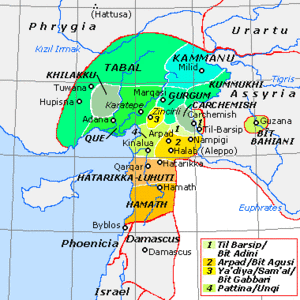Tabal (state)
Tabal Sura? | |||||||||
|---|---|---|---|---|---|---|---|---|---|
| Unknown–713 BC | |||||||||
 Tabal among the Neo-Hittite states | |||||||||
| Common languages | Hieroglyphic Luwian | ||||||||
| Religion | Luwian religion | ||||||||
| Government | Monarchy | ||||||||
| Historical era | Iron Age | ||||||||
• Established | Unknown | ||||||||
• Disestablished | 713 BC | ||||||||
| |||||||||
| Today part of | Turkey | ||||||||
Tabal (Assyrian: 𒋫𒁄) was a Luwian speaking Neo-Hittite kingdom (and/or collection of kingdoms) of South Central Anatolia during the Iron Age. According to archaeologist Kurt Bittel, references to Tabal first appeared after the collapse of the Hittite Empire.[1] Tabal was likely an exonym applied by the Assyrians to Cappadocia.[2] While its native name is uncertain, it is possible that it was called Sura, as mentioned in the records of Yariri, ruler of Carchemish.[3]
History
Originally, Tabal was likely the name of a region or collection of kingdoms. However, Tabal may have later consolidated into a single kingdom, perhaps annexing, or being annexed by, the neighboring kingdom of Melid.[4]
The Assyrian king Shalmaneser III records that he received gifts from their 24 kings in 837 BC and the following year. A century later, their king Burutash is mentioned in an inscription of king Tiglath-Pileser III. The kings of Tabal have left a number of inscriptions from the 9th-8th centuries BC in hieroglyphic-Luwian in the Turkish villages of Çalapverdi and Alişar.
During the reign of Sargon II, Tabal entered in an alliance with the Mushki and Carchemish to counter Assyria.[5]
Toward the end of the 8th century BC, Tabal was at least partially conquered by Assyria.[6]
In 640 BC, inspired by the Cimmerians, the Tabalian king Mugallu rebelled against Ashurbanipal. However, Mugallu was defeated.[7]
Ethnic composition
Some have attempted to link Tabal to the tribe of the Tibareni (Tibarenoi in Greek, Thobeles in Josephus) who lived near the Black Sea.[8][9][10] The Tibareni are mentioned in the works of Hecataeus of Miletus, Herodotus, Xenophon, Strabo, and Apollonius of Rhodes, who stated they were Scythians.[11]
The Tibareni are often viewed as Colchian, and their name may be explained as proto-Kartvelian.[12] The Georgian historian Ivane Javakhishvili (1950) considered Tabal, Tubal, Jabal and Jubal to be an early Kartvelian tribal designation. Cyril Toumanoff also regarded the Tabal (Tubal, Tibal, Tibar) people as proto-Georgians (Kartvelians) who would migrate with the Mushki north to the Pontic region and contribute to the formation of the Kingdom of Iberia.[13]
According to Lorenzo D'Alfonso (2012), the Tabalians may have, at least partially, descended from the Nairi tribe Tuali.[14]
List of rulers
- Tuwati I (Assyrian Tuatti), c. 837 BC[15]
- Kikki, son of Tuwati I, c. 837 BC[16]
- Tuwati II, mid 8th century BC[16]
- Wasusarma (Assyrian Wassurme), son of Tuwati II, c. 740 - 730 BC[16]
- Hulli, 730 - 726 BC[17]
- Ambaris, son of Hulli, c. 721 - 713 BC[17]
- Hidi c. 690 BC[18]
- Iškallu c. 679 BC[19]
- Mugallu/Mukalli c. 670,[18] 663, 651 BC[20]
- x-ussi, son of Mugallu[20] (ca. 650[21]/640[20] BC)
Bibliography
- Ivane Javakhishvili. Historical-Ethnological problems of Georgia, the Caucasus and the Near East. Tbilisi, 1950, pp. 130–135 (in Georgian)
- Simon Janashia. Works, vol. III. Tbilisi, 1959, pp. 2–74 (in Georgian)
- Nana Khazaradze. The Ethnopolitical entities of Eastern Asia Minor in the first half of the 1st millennium BC. Tbilisi, 1978, pp. 3–139 (in Georgian, Russian and English)
References
- ^ Kurt Bittel, Hattusha: The Kingdom of the Hittites, (New York: Oxford University Press, 1970. p.133
- ^ Lorenzo D'alfonso. "Tabal, an 'out-group' definition in the first Millennium BCE." 2012. p. 173. https://www.academia.edu/2951102/Tabal_an_out_group_definition_in_the_first_Millennium_BCE
- ^ Zsolt Simon (2012), Where is the Land of Sura of the Hieroglyphic Luwian inscription KARKAMIŠ A4b and Why Were Cappadocians Called Syrians by Greeks? Altoriental. Forsch., Akademie Verlag 39
- ^ Lorenzo D'alfonso. "Tabal, an 'out-group' definition in the first Millennium BCE." 2012. pp. 183, 186. https://www.academia.edu/2951102/Tabal_an_out_group_definition_in_the_first_Millennium_BCE
- ^ Lorenzo D'alfonso. "Tabal, an 'out-group' definition in the first Millennium BCE." 2012. p. 186. https://www.academia.edu/2951102/Tabal_an_out_group_definition_in_the_first_Millennium_BCE
- ^ Lorenzo D'alfonso. "Tabal, an 'out-group' definition in the first Millennium BCE." 2012. pp. 182-183. https://www.academia.edu/2951102/Tabal_an_out_group_definition_in_the_first_Millennium_BCE
- ^ Lorenzo D'alfonso. "Tabal, an 'out-group' definition in the first Millennium BCE." 2012. p. 183. https://www.academia.edu/2951102/Tabal_an_out_group_definition_in_the_first_Millennium_BCE
- ^ WAINWRIGHT, G. A., Tabal, Tibareni, Tabareni ( OLZ 39, 1936)
- ^ Stephen H. Rapp, Paul Crego. Languages and Cultures of Eastern Christianity: Georgian The Worlds of Eastern Christianity, 300-1500. Routledge, 2018. ISBN 1351923269, 9781351923262.
- ^ Flavius Josephus (AD 93) The Antiquities of the Jews
- ^ Lorenzo D'alfonso. "Tabal, an 'out-group' definition in the first Millennium BCE." 2012. p. 185. https://www.academia.edu/2951102/Tabal_an_out_group_definition_in_the_first_Millennium_BCE
- ^ "Journal of ancient history". 1962.
- ^ Toumanoff, Cyril (1963). Studies in Christian Caucasian History. Georgetown University Press. p. 56.
- ^ Lorenzo D'alfonso. "Tabal, an 'out-group' definition in the first Millennium BCE." 2012. p. 177. https://www.academia.edu/2951102/Tabal_an_out_group_definition_in_the_first_Millennium_BCE
- ^ Trevor Bryce: The World of the Neo-Hittite Kingdoms: A Political and Military History. Oxford, New York 2012, p. 141-145, p. 306f.
- ^ a b c Trevor Bryce: The World of the Neo-Hittite Kingdoms: A Political and Military History. Oxford, New York 2012, p. 141-145, p. 306.
- ^ a b Trevor Bryce: The World of the Neo-Hittite Kingdoms; A Political and Military History. Oxford, New York 2012, p. 141-145, p. 307.
- ^ a b Tübinger Bibelatlas / Tübingen Bible Atlas. Siegfried Mittmann, Götz Schmitt (eds.), Stuttgart: Deutsche Bibelgesellschaft, 2001, Map B IV 13.
- ^ Trevor Bryce: The World of the Neo-Hittite Kingdoms; A Political and Military History. Oxford, New York 2012, p. 293.
- ^ a b c Christian Marek, Peter Frei: Geschichte Kleinasiens in der Antike. Munich 2010, p. 802.
- ^ Ebeling, Erich; Meissner, Bruno (1990). Reallexikon der Assyriologie und Vorderasiatischen Archãologie. Germany: Walter de Gruyter & Co. p. 187. ISBN 9783110104370. Retrieved 26 October 2012.
Apart from this, the text recounts that x-ussi, the successor of Mugallu, king of Tabal...

